Email:
|
If you live in München, what do you do for a vacation? Our German friends go further afield to places like Crete, but Jacky and I had not seen Switzerland, so we decided on a hiking tour there. We signed up for a self-guided tour, which meant the route was defined, and we had maps and a place to stay every night. The touring company carried our luggage… we had only to walk and enjoy. An added attraction of the Bear Trail route was that it went over Große Scheidegg pass, below Wetterhorn, which is featured on a large cycling poster I’ve had for years.
Since we hadn’t been to Switzerland before, we took an extra day or two to explore Bern and Thun before the real hike. Naturally we took the train.
To my surprise, this rail route is not electrified – I thought all major routes were electric. Riding behind a Diesel locomotive is pretty unpleasant: the fumes are a real irritant to eyes and nose. We sure get spoiled quickly! As far as Lindau, we sat next to a Finnish man and his son, the son perhaps 20. Learned something about Finnish geography and culture (famous Finns: Sibelius, Saarinen). Finland joined the EC this year; most people have seen no change, except that food is about 10% cheaper, so they’re happy.
The father recommended Lindau and Bodensee (Lake Constance) as well worth seeing. He had been there many times, was introducing his son to it. He does a lot of Euro-travel, seems to like rural England best, says he’s been there maybe thirty times. We saw our first mountains of the day at Lindau, but it was cloudy and rainy. Bodensee, what we could see from the train, does look nice.
There’s a short stretch through Austria, and we had border police from all three countries walking through the train, checking some or all passports, showing the flag. The train itself was Swiss. These trains are marked SBB, CFF, FFS. Well, SBB clearly stands for Schweizer Bundesbahn; CFF means Chemins-de-fer fédérales, and FFS presumably means the same thing in Italian. Dark green or blue, sometimes red. Nice enough trains, but the washroom doors are hard enough to open that you really have to be motivated!
I had a chance to watch the guard at a couple of the train stops. After checking that everyone was safely on board, he watched the second hand of the station clock. As the hand reached vertical, he blew his whistle, waved his signal to the driver, and climbed aboard as the train began to move. Swiss precision (same in Germany, of course).
First impressions of Switzerland: green, neat, tidy – like Germany. But not the same: pick a random church, for example, and it will be smaller and plainer, protestant, no onion dome. Pick a random car: it’s less likely German made, more likely a Renault, a Citroën, a Fiat. Pick a random house: it will be masonry with a stucco finish, but the stucco will be pastel instead of white; it probably won’t have a mural. It will have a tile roof, but the tile will tend more toward brown than red. Or it will have deep, dark, weathered wooden eaves. But, as in Germany, it will probably have window boxes full of bright red geraniums. Switzerland is only disappointing in the amount of graffiti you see, on urban buildings and civil works. More than in Germany, and it seems out of character with the rest of the country.
Signs in this part of Switzerland are always in German, usually in a second language, which is English as often as French. Sometimes in all four languages. And no mountains! (Maybe we just can’t see them on a cloudy day?)
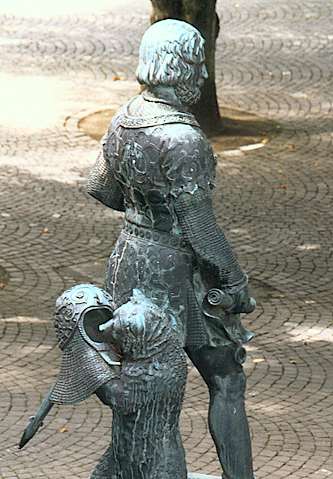
The weather cleared up as we left Zürich, and we began to see mountains as we got further toward Bern. Arrived in Bern in early afternoon, a busy, bustling, beautiful bear city. Tried to get some money from the Geldautomat in the Bahnhof, but it refused my request. Jacky got money with her card, no problem. Go figure!
Although our hotel, Hospiz zur Heimat, was only three blocks from the station, they are long blocks in this direction, and we were happy to reach the place. The book describes it as beautiful on the outside, dormitory-like on the inside. Well, true, but the room is large and clean, the hotel has a good location, it’s a moderate price, and we don’t plan to spend all that many of our waking hours there anyway. As it happened, it was the only double bed we had all week. No complaints.
As soon as we had checked into the hotel, we went out for a walk, of course. One block up from the hotel is the house where Einstein worked out the theory of relativity. Impressive neighbors!
From the air, Bern would resemble Wasserburg, built on an ox-bow in a river, the Aare in this case. Unlike Wasserburg, however, the terrain on either side is a lot higher. The old town proper is built at the top of the hill in the middle of the ox-bow; at the bottom of the hill is a ring of less well-defined buildings, infra-structure, you might say. The hill is too steep to build on, so it’s forest, park, garden. Green – mostly only for the eyes, since it’s too steep even to walk on. At water level is at least one bridge from antiquity, and at least one new recreation path bridge. The bridges from the city proper connect between the high terrain on either side.
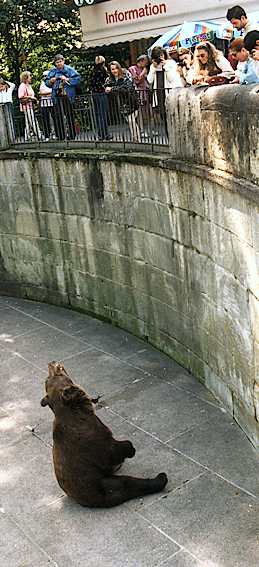
Headed for the Bärengraben, the bear pits where the city keeps a sample of its mascots. Everything in Bern is focussed around bears. They’re clowns, fat from the food the visitors throw down to them. They invariably catch the food in mid-air, without effort. Signs at the top forbid the feeding of meet and sweets – the recommended fodder is carrots.
What I especially liked about this mural is the guy with the movie camera.
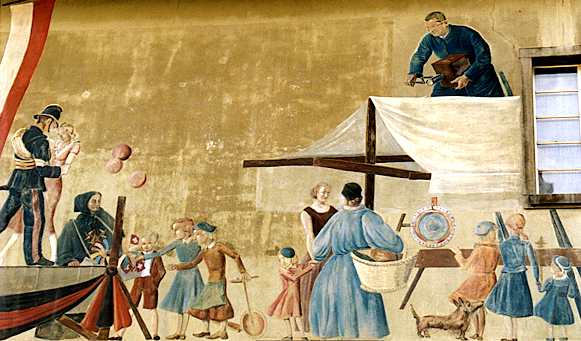
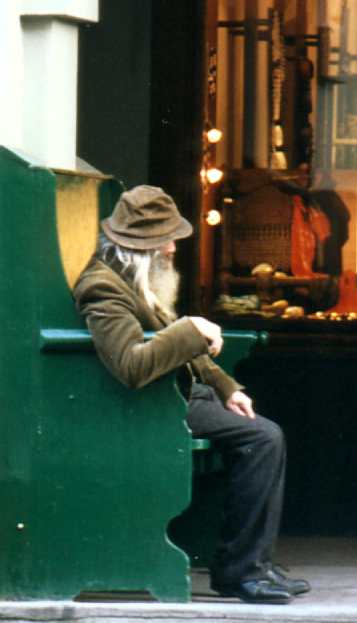
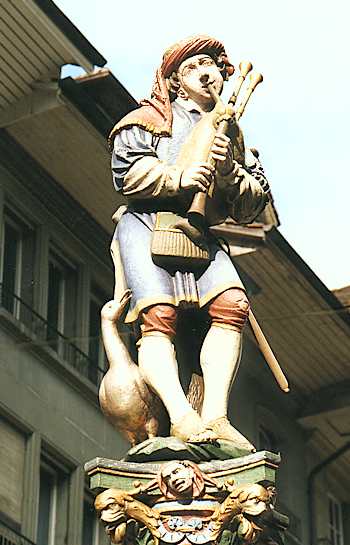
Bern is busy but not jammed. Fewer cars than you’d expect.
There are a number of painted statues in the streets – a few of them showing wit and humour, but most of them very straight, and therefore not worth a picture, even though they’re four hundred years old.
Found a bio food store, got some Müsliriegel (granny bars) and mixed nuts for our hiking days. Stopped about 4:30 for pizza, expensive even in Deutschmarks, and the Swiss franc is worth about DM 1,25. People warned us that Switzerland is expensive! We’ll avoid spending more than we have to. The pizzeria windows were old wavy glass, an interesting perspective on the world beyond.
The long blocks in the old town are saved by numerous passages and Gäßchen that link adjacent streets. The center city is all arcaded, six kilometers worth. The arcades originated when the city was rebuilt in stone after fire destroyed the wooden city in 1405; they were workshops for the artisans doing the reconstruction.
The buildings are made from the local sandstone, a pleasant gold colour, with almost a hint of olive. It’s only a shame there isn’t a bit more variety.
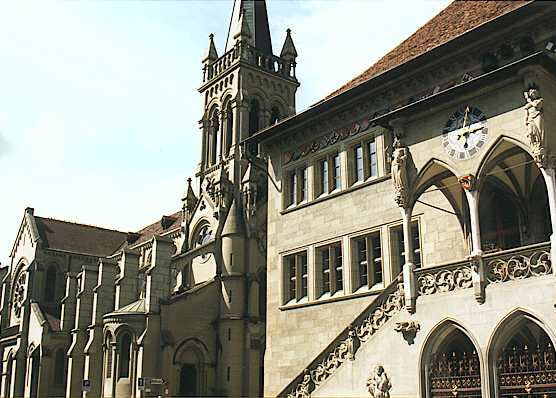
Next to the Rathaus is the Christ Catholic church. The idea seems to be that people can find their way to heaven without the help of a pope and the Roman administration, thank you very much. This leaves me wondering what the word Catholic means, once you eliminate Rome.
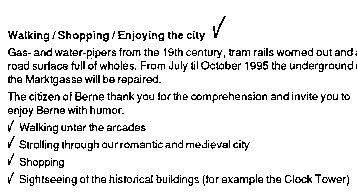
The central city is paved in stone. They were rebuilding Marktgasse, and had printed up delightful flyers explaining why. Stone paving, from our observation, can be done just about as fast as concrete paving.
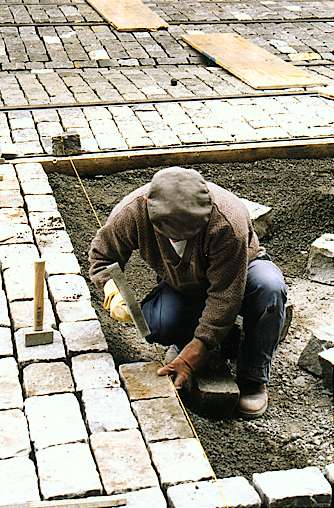
Then back to the hotel for naps that turned out to last all night. Long day: a new city, a new country, the start of an adventure.
More…
View Guestbook
Jacky’s home
Dave’s home
View old guestbook
Email: ![]()